| |
Hats & Cloaks
|
|
The suggestion that the photograph could be a portrait of the Bronte
sisters has been criticised mainly because of the hats, or rather the hat worn by
'Emily', because it does appear to date to the 1860s and not to the 1840s. This page
traces the origins of the hat in Britain.
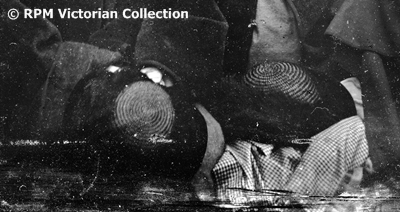
The straw hats held by 'Charlotte' and 'Anne' (above) are partly obscured so it
is not possible to tell whether they are exactly the same style as the one worn by 'Emily'
(below). This has a round, low-crown with the brim turned up at the sides and is
similar if not identical to a riding hat seen in photographs from the early
1860s. If the hat dates from the 1860s then these are certainly not the Bronte
sisters because Emily died in 1848 and Anne in 1849.

The hat worn by 'Emily' in the photo.
When was this hat introduced to Britain and Is there any evidence
that it existed in the 1840s?
|
|
Women's hats in the
1840s
|
|
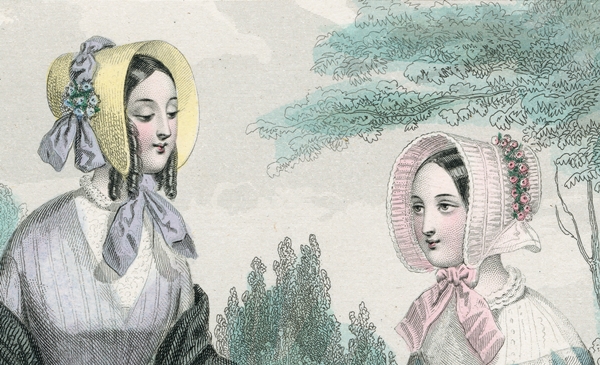
Bonnets - detail from a fashion plate in Le Follet, August,
1845.
In the 19th Century, women's fashions in Britain were strongly
influenced by a mixture of propriety and Parisian fashions and this ensured
that the bonnet remained the main outdoor headwear throughout the 1840s and
1850s. By the late 1830s hats had been demoted in status
to informal headwear and they rarely merited an appearance in
fashion journals until the late 1850s.
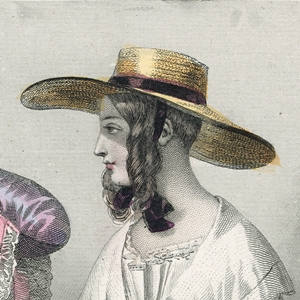
Wide-brimmed straw hat; detail from a fashion plate in Le Moniteur de
la Mode, July 1844.
Women's hats did not disappear altogether in the 1840s. Milliners throughout the
country continued to sell them in addition to bonnets. They were worn in the garden, at the seaside
and in the country, away from larger towns and cities where dress codes were more
relaxed. They were usually made of straw and most had a wide, floppy brim.

A satirical sketch of the floppy, wide-brimmed English straw hats worn
in the countryside in the 1840s.
For wealthier women with an interest in sports, archery was about the only
option available in the 1840s. Illustrations from this period show that whilst bonnets
were often worn, others chose to wear the wide-brimmed hats.
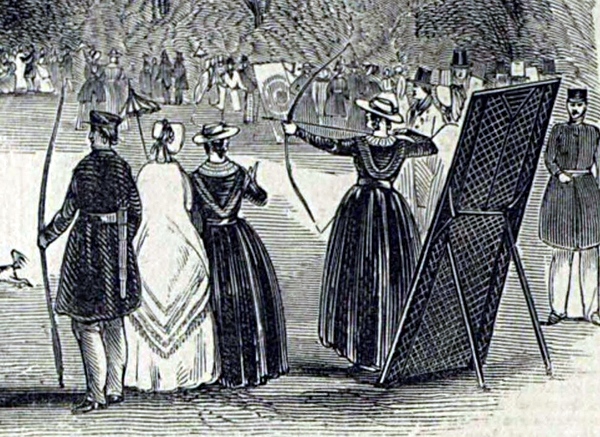
Detail from an engraving of an archery meeting, Pradoe, Oswestry, Shropshire, 1844. Women did not participate in many sports in the 1840s apart from archery, which
was extremely popular and where either bonnets or hats were acceptable headwear. The National
Archery Meeting was held in York in 1844.
After walking, the most common outdoor leisure pursuit for many women
was horse-riding and some found riding hats more practical than bonnets. Royalty
also influenced Victorian fashion, just as it does today, and the styles
worn by the young Queen Victoria in the 1840s were copied and sold by milliners throughout the
country.
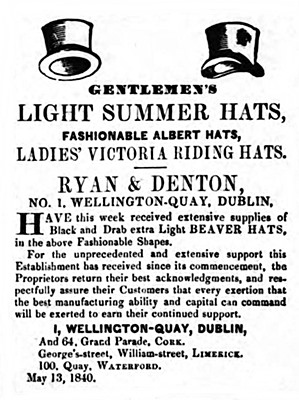
Advert for men's Albert Hats and ladies' Victoria Riding Hats, Ryan
& Denton of Dublin, Cork, Limerick & Waterford, 1840.
The main outdoor headwear for women in 1840s Britain was
bonnets with informal headwear consisting mainly of floppy rustic straw hats and stiff,
formal, riding hats, with one notable exception.
|
|
The Jenny Lind Hat
|
|

Jenny Lind
(1820-87)
|
The only radically different woman's hat to appear in
1840s Britain was known as a 'Jenny Lind', named after the Swedish opera
singer who caused a sensation when she came to this country in 1847. Existing hats
for women in the 1840s were limited mainly to the informal wide-brimmed
straw variety, or the formal riding hat style. The 'Jenny Lind' was
a complete departure from these modes. 1.
It was virtually identical to a man's 'wide-awake' hat,
low-crowned with the brim sweeping up at the sides. The hat does not appear to have
been the product of a Parisian fashion house, nor was it promoted by Jenny
Lind.
It emerged out of the 'Jenny Lind Fever' or 'Lindmania' which
swept through the country in the late 1840s. The adulation of Jenny Lind by
the British (and later the American) public can only be likened to the
Beatlemania of the 1960s.
|
|

The hat used by Jenny Lind in Donizetti's opera
'La figlia di Reggimento'.
Source: Wikimedia Commons 'Jenny Lind Fille du
Regiment'
This style of hat did not exist in Britain until 1847.
The hat was based on the one worn
by Jenny Lind in the opera 'La figlia del Reggimento' (The Daughter of the
Regiment) where she played the role of Maria, a French vivandière. This was a replica of the vivandière or
cantinière hat worn by women in certain regiments of the French Army.

The hat worn by 'Emily' in the
photo.
|
MATERIALS
The hat was produced in felt, but the straw version seems to have
been more popular. These were sold in Britain from 1847 until about 1863 including
smaller hats produced for boys & girls. Adverts also exist in this period for the 'Jenny
Lind Riding Hat' which may have been promoting the same hat or
perhaps some modified type with a narrower brim.
DISTRIBUTION, EXPORT & THE AMERICAN VERSION
They probably first became popular in the West End of London in May 1847 but
within weeks the hats were on sale in other parts of the country. They could certainly be found in
the towns and cities visited by Jenny Lind during her tours of Britain. In the run up
to her arrival the local shops stocked up on all 'Jenny Lind' memorabilia, such as mantles,
handkerchieves, boas, hats, pictures, snuff boxes and sheet music etc.,.

Advert for Jenny Lind Hats, June, 1847: George Burrington, Hatter, 81
Fore Street, Exeter, Devon.
'Jenny Lind hats' were shipped out, along with other headwear, to milliners in
other parts of the world. They were being sold in shops in Tasmania by
January 1848. Tuscan and Dunstable straw versions arrived in Sydney, Australia by
September 1848. They were also exported to America and by March 1848 they were on sale in
Louisville, Kentucky, some two years before Jenny Lind arrived in the United States.
Jenny Lind toured America with P.T. Barnum in 1850-2 and the New York hatter, John Nicholas Genin, promoted his own 'Jenny Lind Riding Hat'
which was immensely successful. Descriptions of this American version vary enormously so an
example cannot yet be given.
'POPULAR' BUT 'UNFASHIONABLE'?
In 1847 the hat was probably considered by most people in Britain to
be 'popular' rather than 'fashionable'. It was not designed by a
Parisian milliner and women's hats were still considered to be very informal
headwear. The first 'known' illustration of it in a fashion journal is in 1856, as a straw
riding hat. It was exactly the same hat, so it was probably sold by some
British milliners as a rustic riding hat, but others continued to
advertise it as the 'Jenny Lind'.
One of the last adverts found in a British newspaper for a 'Jenny Lind'
hat is in 1854, when hats were becoming more socially acceptable, new styles
were emerging. This style of hat went out of fashion about 1863 and the gradual demise of the
bonnet began.
|
|
The Jenny Lind Hat in the 1840s & 1850s
|
|

The hat worn by 'Emily' in the
photo.
The hat worn by
'Emily' in the photo can be seen in photos dating to the early 1860s, but these are
usually carte de visite photos which were only produced from about 1860. It can also be
seen in collodion photographs, which existed from the 1850s until the 1890s, but
these are mostly undateable. Fortunately the hat does occasionally appear in illustrated
newspapers and journals throughout the
1850s.
|
1847
|
|
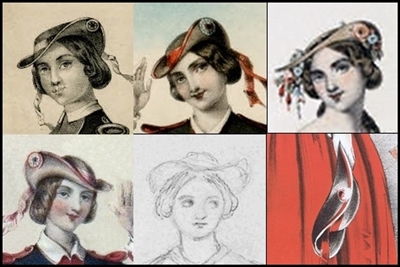
Depictions of Jenny Lind
as Maria in La figlia del Reggimento 1847-9.
These images are taken from engravings of Jenny Lind as she
appeared in the opera The Daughter of the Regiment. In June 1847 Queen
Victoria, one of Jenny Lind's greatest admirers, made a small pencil sketch
and watercolour of her in her vivandière hat and costume. These can be seen on
the Royal Trust website (RCIN 980011.ad & RCIN 980011.ai)
|
"A CHOICE VARIETY OF THE NEW JENNY
LIND HATS, TRIMMED AND
PLAIN"
Advert for Mrs E. Pratt, Milliner, 16, High
Street, Wolverhampton (Wolverhampton Chronicle and Staffordshire
Advertiser - Wednesday 28 July 1847 p.2) 1a.
|
Jenny Lind hats were smaller than the wide-brimmed
hats worn by adults and children. 2.
|
"The polka-craze was certainly big in Paris,
two or three years ago, but it is nothing compared to the result of
the prima donna's songs which fashion has taken under its wing. In
Paris we had polka clothes and that's all; in London, all fashions
are Jenny Lind. Jenny Lind Dress, Jenny Lind Hat, Jenny Lind
collars, Jenny Lind Tobacco Pouch.
"Le charivari (Paris, France) 28 August 1847
(col.3) 3.
|
|
"R. Bissington
respectfully invites the Attention of Ladies to these
Goods in all the Newest Designs of the Season, embracing the
PALAIS ROYAL, JENNY LIND, CLARENCE, PRINCE EDWARD,
&c."
Richard Bissington, 34, Briggate,
Leeds & 16, Market Place, Hull.
(Leeds Mercury, Yorkshire, Saturday 6
November 1847)
|
|
|
c1848
|
|

A Royal Staffordshire figure of Jenny Lind produced
1847-9.
Even before she arrived in Britain, pictures of Jenny Lind
were on sale, mostly engravings made from portrait paintings. Some of these
graced the covers of sheet music, including The Daughter of the
Regiment where she wears the vivandière hat. The Royal Staffordshire figures produced c1847-9 were at
least partly based on these portraits.
|
|
1849
|
|
Before 1850s dress reform &
Bloomerism.
Women's cricket was
something of a novelty in the 1840s but in one of these rare events
in 1849 these Hampshire ladies were not wearing floppy straw hats or
bonnets:
"On Thursday week,
the return cricket match between the Ringwood [Hampshire] married and single
females took place at Picket Post, and from the fineness of the day immense
numbers attended. The ladies were dressed in white, wearing Jenny
Lind hats, the single displaying pink sashes, and the married blue.
The manner which many of them handled the bat and ball proved that they
had not been remiss in practice, and had received tuition from one well
skilled in the noble game. At the close of the game, the single were again
declared victorious, with 5 wickets to spare."
(Devizes and Wiltshire Gazette -
Thursday 20 September 1849).
|
|
1850
|
|
s.JPG)
Detail of wide-awake riding hat
from an illustration in Punch magazine. vol 18, p.236
(1850)
|
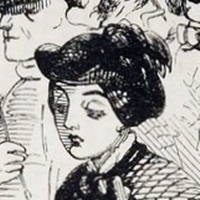
Detail of wide-awake riding
hat from an illustration in
Punch magazine, vol.19-p.25 (1850)....John Leech was very aware of changes in women's fashions and
created many of the illustrations seen in Punch Magazine.
|
|
1851
|
|
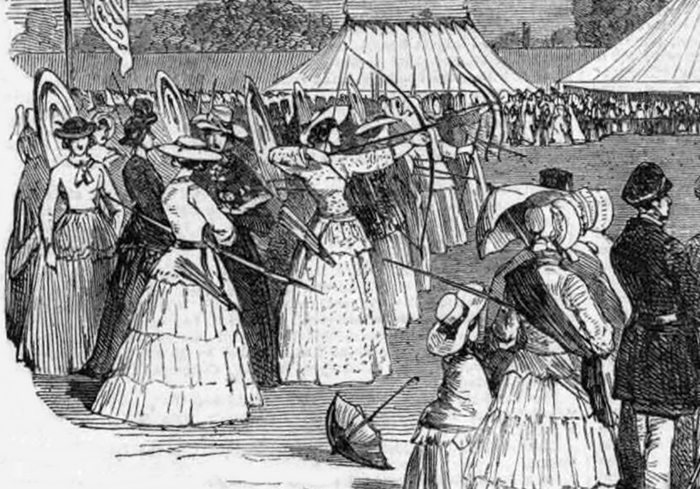
National Archery Meeting, Leamington, Warwickshire, 1851 showing
various types of headwear including one Jenny Lind or wide-awake style hat, several
wide-brimmed hats with high & low crowns, a child with a floppy straw hat
and many bonnets.
Detail
from an image in the Illustrated London News - Saturday 5 July
1851.
|
"Ladies'
Fashionable Rustic Riding Hats, as generally worn at the West End
of
London."
Richard Bissington, London Hatter, 34, Briggate,
Leeds & 16, Market Place, Hull.
Leeds Times, Saturday 19 July 1851.
|
|
|
1853
|
|

Left: Copy of a pencil sketch of Jenny Lind as Maria,
1847.
Right: Detail of wide-awake riding hat from an engraving in
Punch magazine, June, 1853.
|
|
1854
|
|
"R.
Bissington respectfully solicits Attention to the newest Designs in
SILK BEAVER and FELT HATS and BONNETS. The NEW JENNY LIND HAT is
the most
prevailing."
Richard Bissington, London Hatter, 34, Briggate,
Leeds & 16, Market Place, Hull
(Leeds Intelligencer, Yorkshire, Saturday 28 October
1854)
------
Millinery, Bonnet and Fancy Drapery
Establishment,
Opposite the Guildhall, Exeter.
Mrs C. ADAMS
HAS JUST RECEIVED A LARGE ASSORTMENT OF CRINOLINE, MILLINERY, AND
FANCY STRAW BONNETS:
Also, a New Stock of
YOUNG LADIES AND GENTLEMAN'S LEGHORN, TUSCAN, AND, STRAW HATS,
including the fashionable "Jenny Lind"
Shape,
And of which she respectfully solicits an early inspection.
58, High-street, June 15th, 1854.
(Western Times, Exeter, Devon - Saturday 17 June 1854
p.4)
|
|
|
1855
|
|
In the Copdock Archery Club's Fete,
at The Chauntry, Suffolk, on 22 August 1855, the ladies wore:
"a green silk jacket,
white muslin skirt flounced, and grey felt Jenny Lind hat,
bound at the edges with green ribbon, and set off with a white or green
feather."
Essex Standard - Friday 31 August
1855.
|
|
1856
|
|
Changes in fashion were not unconnected to the alliance between
Britain and France in the Crimean War.
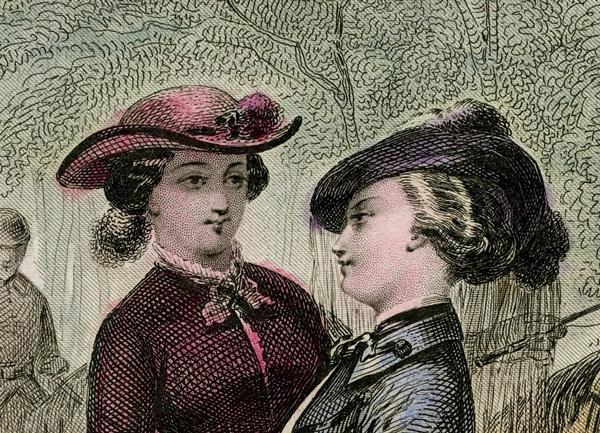
Earliest known appearance of the hat in a fashion
plate: Journal des Demoiselles, 1856, p.126-8.
|
|

ABOVE: Detail from a photo of Princesses Helena and Louise © Royal
Photographic Society.
|
|

|
LEFT: Princess
Helena © Royal-Collection-Trust. The photos (above and left) were taken in
1856 by the Lancashire-born photographer, Roger Fenton. The previous year he had
spent three months making a photographic record of the Crimean War.
BELOW: The hat worn by 'Emily'.

|
|
1857
|
|
The English Hat in Paris.—The fashion set by
English ladies of wearing hats instead of bonnets has, after being a good deal
ridiculed, been adopted by actresses and lorettes. It is always those two classes
of the community who experimentalise new fashions, especially those of an eccentric
character.
There are indications that from them the new mode will soon
reach ladies of respectability, and that it will in time become general. It is said
that the Princess Mathilde has adopted it, but that the Empress has pronounced
against it. As, however, Her Majesty in her shooting excursions at Compiegne and
Fontainebleau figures in a hat, and as it became her remarkably well, it is
probable that her pronunciamento against the new fashion is not final and
irrevocable. (BEADS FROM THE BRACELET OF FASHION) Cheltenham Looker-On - Saturday
03 January 1857)
|
The riding hat seen in photos of the early 1860s is a 'Jenny
Lind Hat' in all but name. It can be traced back to London in 1847, was the
only 'wide-awake' hat for women in the whole of this period, and the
style remained popular for over 15 years.
The elegant form of the hat with a graceful, sweeping, brim was
only part of its appeal, for some women it was far more practical than a
bonnet, but there was also the connection to Jenny Lind. Most of the nation,
including the majority of the British Press, held her in high esteem; she
was a philanthropist and one of the few female role models of the 1840s. Her success in Britain,
the 'Jenny Lind Fever' and the popularity of the 'Jenny Lind' hat, were all events taking place in
1847, just as the three Bronte sisters' ground-breaking novels were accepted for
publication.
The 'Jenny Lind' hats, and what might today be termed 'Jenny Lind
unofficial merchandise', was more common in towns she visited during her tours of
1847-9. In 1847 she performed in Hull. Her concert at York was cancelled at the last
minute, but crowds did catch a glimpse of her at York Railway Station. Another concert in
Sheffield the following week was also cancelled.
|
|
Did the Bronte sisters
ever wear hats?
|
|
The sisters would have worn bonnets in the 1840s but there is mention of them
wearing hats:
"Eh, dear, when I think about them I can see them as plain to my mind's eye as if they
were here. They wore light-coloured dresses all print, and they were all dressed alike until
they gate into young women. I don't know that I ever saw them in owt but print. I've heard it
said they were pinched [short of money] but it was nice print: plain with long sleeves
and high neck and tippets down to the waist. The tippets were marrow to their dresses and
they'd light-coloured hats on. They looked grand.
If my memory serves me correctly, I believe the Miss Brontes' dresses have been
criticised by others as being somewhat quaint and prim and old-fashioned and indeed anything
but 'grand,' but then these critics had not lived in Haworth all their lives and brought up a
family on twelve shillings a week hard-earned in a mill as had my old lady."
4.
Descriptions of headwear in the Victorian era can be very deceptive because the
terms "hat" and "bonnet" were, depending on the writer,
interchangeable. Did this lady think that the Bronte sisters "looked
grand" wearing "light-coloured hats" or wearing "light-coloured
bonnets"?
|
|
The Cloaks
|
|
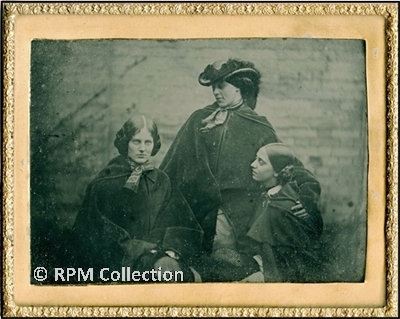
The three women in the photo are wearing
hooded cloaks. 'Charlotte' and 'Emily' have thick fleece travelling cloaks with sleeves
but 'Anne' is wearing a cloak made of a thinner fabric. It has been suggested that this
may be because Charlotte and Emily travelled to Belgium in
February 1842 whilst Anne remained in Yorkshire, working for the Robinson family.
|
|
|
|
Any missing sources will be added towards the end of November 2018.
There is more information concerning the hats and so this page will probably be revised
at some point in 2019.
|
|
The Yorkshire
Vivandière
|
|
Just as a note of interest, in the 1850s & 1860s volunteers rifle corps were formed in most towns in Britain. The
Leeds Engineer Volunteer Corps was probably unique in
having in its ranks, a Vivandière. When the rifle corps paraded through the
centre of Leeds they were led by a woman wearing the costume of a French
vivandière. 5.
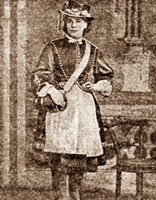
The Vivandière of the Leeds
Engineer Volunteer Corps, 1865.
|
|
1. The English dialect dictionary, George
Wright, 1903. Volume 4, p.358 Entry for 'Jenny Lind'
(Yorkshire & London).
Brighton Gazette - Thursday 30 April 1857 col.5
"HER MAJESTY'S THEATRE" [London] "....La Figlia del Reggimento was presented for the first
appearances this season.. Mdlle. Piccolomini looked more piquant and charming than ever. The
dress of the vivandiere suits her to admiration, and then she has laid aside the
Jenny Lind wide-awake — not to speak of it
irreverently — and donned in its place the prettiest little undress or forage cap imaginable —
the proper cap, be it observed, of the "Undecimo.”
1a. For information on Richard Bissington, hatter &
milliner, of Hull and Leeds, Yorkshire, see the Thoresby Society website. There is a photo of the Leeds branch on the
Leodis website.
2. "Labour
and the poor" [a straw plaiter interviewed in connection with Henry Mayhew's research] " Morning Chronicle - Friday 05 April 1850 p.5,
col.4. : "The little 'Jenny Lind' hats we get 4½d [about 2p
decimal] for. I dare say I could make three of them in a day. I never did much of
them though; they're for summer wear. Them very large broad brimmed ones as the children
wears they get 1s. 9d. [about 9p decimal] for making the finest quality,
some 1s.6d., [about 7½p decimal] some 1s.[5p decimal], and so on. It
all depends on the fineness of the plait; the courser the plait is, you know, the less time
it will take us to make it."
Jenny Lind hats for adults were smaller than some of the
children's hats at this time. In the late 1840s many children's hats became very
wide-brimmed, as noted in the exaggerated illustration (below) from Punch,vol 8. (1847),
p.28.

3. Le charivari — 28 August 1847
(col.3): "Certes la folie de la polka était bien grande à Paris,
il y a deux ou trois ans, mais ce n est pas à comparer au résultat des chansons de la prima
dona que la mode a prise sous sa protection. A Paris nous avons eu des habits polka et voilà
tout ; à Londres, toutes les modes sont à la Jenny Lind. Robe à la Jenny Lind, chapeau à la
Jenny Lind, faux-cols à la Jenny Lind, blague à tabac à la Jenny Lind."
4. Reminiscences of an 87-year-old lady, an
ex-resident of Haworth, in an article by C. Holmes Cautley: ‘Old Haworth Folk Who knew the
Brontës’. The Cornhill Magazine, New Series Vol. XXIX. July to December 1910.
pp.81-82. Smith, Elder, & Co., 15 Waterloo Place, London. Please note that in this article Mrs Ratcliffe's
"photograph on glass of the three sisters" is mentioned but this was an 1850s photo
of Branwell's 'Pillar' group portrait painting of the sisters.
5. Leeds Intelligencer - Saturday 23 September
1865, p.7.
"One of the most pleasing incidents of this
inspection was the appearance for the first time in Leeds of a vivandiere. She
marched in front of the regiment escorted by a Serjeant on each side, over the barrel
pier bridge, through the town to the Militia Barrack Yard in Carlton-lane, and was
very much admired by the tens of thousands who saw her, for her personal appearance,
the excellence of her style of marching, and her very modest
demeanour.
One of the officers of the Leeds
Engineers being in France a short time ago, and seeing a regiment of the line on the march
with a vivandiere in full uniform, marching at the head of the regiment behind the band,
was so much pleased with the evident usefulness of such an officer, that he volunteered to
supply the dress and accoutrements for one. A young lady undertook the office, her dress
was a copy from the uniform of the French vivandiere, but with the colours of the
engineers.
The jacket is scarlet with three rows
of silver buttons; petticoat Oxford grey with stripes of garter blue and scarlet ;
trousers, garter blue, with outside broad scarlet stripe; white shirt collar, with blue
tie; French white apron with pockets, and trimmed with blue and scarlet; white gauntlets
and kid gloves; straw hat covered with black oiled silk, and scarlet and blue cockade with
streamers; a regulation pouch belt to which was strung a barrel containing a quart of fine
old Cognac brandy; laced boots of black patent leather and red morocco.
Altogether her appearance was most prepossessing. When the
regiment marched past Col. Wombwell, the inspecting officer, in review order, she marched
alone in front of Lieut-CoL Child and Major Smith, and was much admired by all who saw
her.
It is to be hoped that at the next
review many volunteer regiments will have followed the example of the Leeds Engineers, and
that a regular staff of vivandieres will then be ready to assist in such cases of sudden
illness as took place at one of the reviews at Doncaster, when the services of two nurses
from the Leeds Infirmary had fortunately been previously procured."
|
|
|

